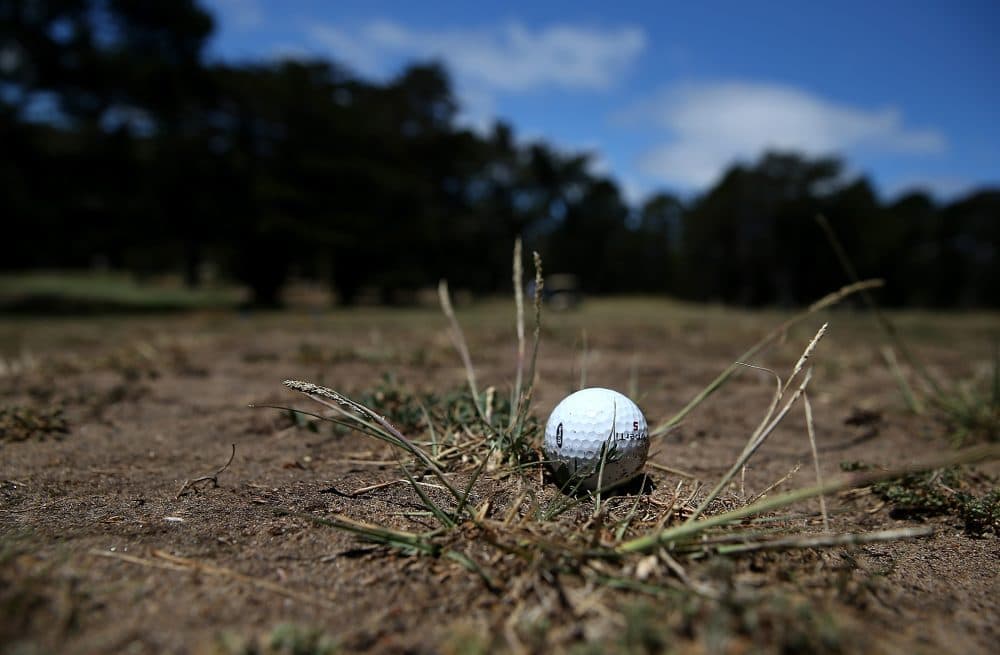Advertisement
Global Warming And Its Effect On The $70-Billion Golf Industry

Golf has a global economic impact of about $70 billion a year, and a charitable impact as high as $4 billion, with 143,000 annual events. So it’s not surprising that courses around the world are scrambling to mitigate against the current and projected impact of climate change on the links.
Courses including Riverbend and Valhalla in the U.S. are among those that have taken measures to prevent further climate damage, and in the UK, Donald Trump’s Trump International Golf Links Ireland recently filed a permit to erect a seawall at its course in County Clare.
Here & Now's Robin Young talks with Richard Windows, a turf agronomist from the Sports Turf Research Institute in Glasgow, Scotland about golf and climate change.
Read Richard Windows' report on golf and climate change
Interview Highlights: Richard Windows
On the impacts of too much water on the course
"Flooding and grass doesn't go well together, so effectively the grass just suffocates. It happens everywhere, certainly on the Ayrshire coast where the Open Championship is going to be played at the Royal Tron this year. We had an over meter of rainfall between late November and late February this year, which is a huge amount of water. In addition to that, we also have these storms and high tide, so we had lots of flooding down on the west coast of Scotland and west coast of the UK this year.
The situation that we find ourselves in, is real. We're certainly seeing wetter conditions. The grass is growing for longer, back 10, 15 years ago, greens mowers would be put away in October. Now we're moving grass until Christmas. At the same time we're receiving wetter weather, so the grass is growing more strongly but we can't get out to cut the turf because ground conditions are so soft and wet underfoot."
"Green isn't good. You don't play golf on color, you play golf on grass."
Richard Windows
On what’s being done to adapt to climate change
"We do understand that golf needs to fit into the landscape as opposed to impose itself upon it. So we've always been very sort of judicious with our water and fertilizer and pesticide usage. But, I think with climate change, milder, wetter winters and hotter, dryer summers, we just need to be more effective how we use water. So better drainage systems in the winter and capturing that winter drainage and storing it for summer uses, but also kind of thinking about the grass type that you've got. Certain grasses require more water than others. So favoring grasses that are more drought tolerant and also more disease tolerant because warm, mild conditions results in more disease activity."
On the brown golf courses in Scotland and "browning out"
"The presentation and the look of the golf course reflects the weather conditions that we've had, so if we have an extended period of dry weather in the summer, the golf course naturally browns out, it plays fantastic. But, it's absolutely important that we have the right grasses to be able to do that, so they're all indigenous perennial type grasses like fine fine fescues and browntop bent. They can withstand drought. So they look as though they've died, but they haven't they just gone dormant, they've shut themselves down, we get a shower of rain and they bounce back, they green up and they're still alive, so that's very much authentic to how we present our golf over courses here. Green isn't good. You don't play golf on color, you play golf on grass."
Guest
Richard Windows, turf agronomist at the Sports Turf Research Institute and author of “Climate Change and Scottish Golf Courses,” a 130-page report on the impact of climate change on golf. He tweets @striturf_richw.
This segment aired on June 24, 2016.